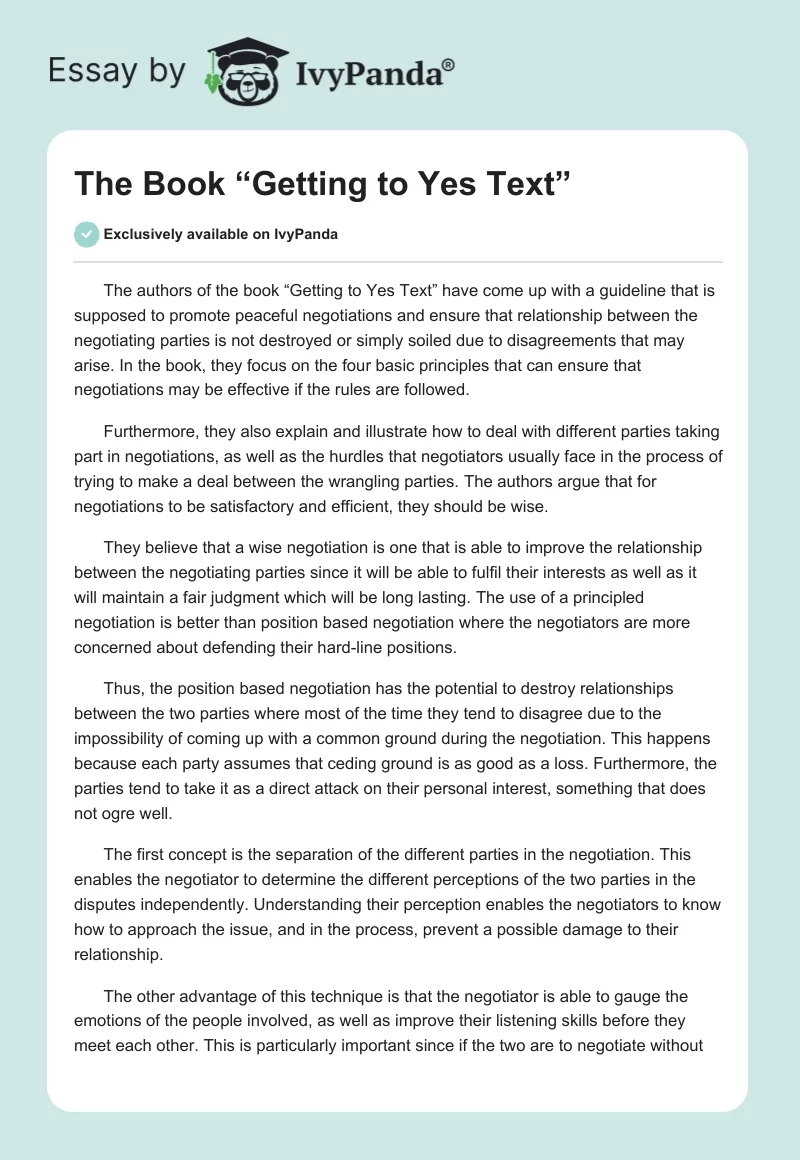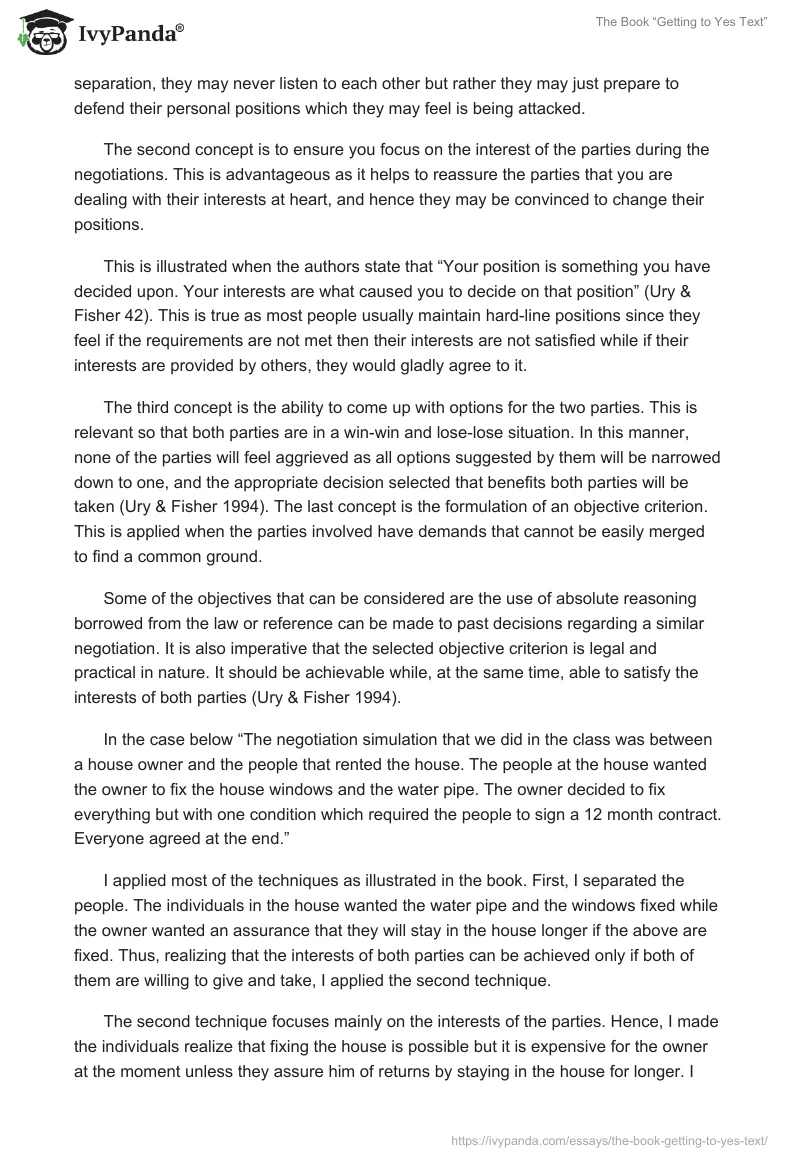The authors of the book “Getting to Yes Text” have come up with a guideline that is supposed to promote peaceful negotiations and ensure that relationship between the negotiating parties is not destroyed or simply soiled due to disagreements that may arise. In the book, they focus on the four basic principles that can ensure that negotiations may be effective if the rules are followed.
Furthermore, they also explain and illustrate how to deal with different parties taking part in negotiations, as well as the hurdles that negotiators usually face in the process of trying to make a deal between the wrangling parties. The authors argue that for negotiations to be satisfactory and efficient, they should be wise.
They believe that a wise negotiation is one that is able to improve the relationship between the negotiating parties since it will be able to fulfil their interests as well as it will maintain a fair judgment which will be long lasting. The use of a principled negotiation is better than position based negotiation where the negotiators are more concerned about defending their hard-line positions.
Thus, the position based negotiation has the potential to destroy relationships between the two parties where most of the time they tend to disagree due to the impossibility of coming up with a common ground during the negotiation. This happens because each party assumes that ceding ground is as good as a loss. Furthermore, the parties tend to take it as a direct attack on their personal interest, something that does not ogre well.
The first concept is the separation of the different parties in the negotiation. This enables the negotiator to determine the different perceptions of the two parties in the disputes independently. Understanding their perception enables the negotiators to know how to approach the issue, and in the process, prevent a possible damage to their relationship.
The other advantage of this technique is that the negotiator is able to gauge the emotions of the people involved, as well as improve their listening skills before they meet each other. This is particularly important since if the two are to negotiate without separation, they may never listen to each other but rather they may just prepare to defend their personal positions which they may feel is being attacked.
The second concept is to ensure you focus on the interest of the parties during the negotiations. This is advantageous as it helps to reassure the parties that you are dealing with their interests at heart, and hence they may be convinced to change their positions.
This is illustrated when the authors state that “Your position is something you have decided upon. Your interests are what caused you to decide on that position” (Ury & Fisher 42). This is true as most people usually maintain hard-line positions since they feel if the requirements are not met then their interests are not satisfied while if their interests are provided by others, they would gladly agree to it.
The third concept is the ability to come up with options for the two parties. This is relevant so that both parties are in a win-win and lose-lose situation. In this manner, none of the parties will feel aggrieved as all options suggested by them will be narrowed down to one, and the appropriate decision selected that benefits both parties will be taken (Ury & Fisher 1994). The last concept is the formulation of an objective criterion. This is applied when the parties involved have demands that cannot be easily merged to find a common ground.
Some of the objectives that can be considered are the use of absolute reasoning borrowed from the law or reference can be made to past decisions regarding a similar negotiation. It is also imperative that the selected objective criterion is legal and practical in nature. It should be achievable while, at the same time, able to satisfy the interests of both parties (Ury & Fisher 1994).
In the case below “The negotiation simulation that we did in the class was between a house owner and the people that rented the house. The people at the house wanted the owner to fix the house windows and the water pipe. The owner decided to fix everything but with one condition which required the people to sign a 12 month contract. Everyone agreed at the end.”
I applied most of the techniques as illustrated in the book. First, I separated the people. The individuals in the house wanted the water pipe and the windows fixed while the owner wanted an assurance that they will stay in the house longer if the above are fixed. Thus, realizing that the interests of both parties can be achieved only if both of them are willing to give and take, I applied the second technique.
The second technique focuses mainly on the interests of the parties. Hence, I made the individuals realize that fixing the house is possible but it is expensive for the owner at the moment unless they assure him of returns by staying in the house for longer. I also explained to the owner that the individuals in the house were willing to stay in the house longer if their requests and demands are attended to. This way, none of the parties would feel that their interests have been neglected.
Armed with this information, I applied the third technique where the owner was to fix the whole house as long as the individuals signed a contract of staying in the house for a minimum of a year. At this point, both parties had their interests met but their positions were ceded. This is evident since the owner now had to fix the whole house in return for the contract while the individuals had to sign a 12 month contract in return for the fixing.
In the end, all parties were satisfied with the decision after I had correctly applied the tools discussed. In conclusion, it is justifiable to use the tools illustrated in the book. The tools are advantageous as they enable parties to come up with an amicable solutions that satisfy both their interests while, at the same time, ensure that their original interpersonal relations remain the same.
For instance, in the abovementioned case, the owner of the house fixed the whole house, while the individuals in the house signed a contract yet they still maintained their good relations. Ignoring these techniques often leads to bruised personal relations between the parties since if their self-interests are not satisfied, they will always feel that the other party is attacking them and hence they will tend to revolt.
Works Cited
Ury, William & Roger Fisher. Getting to Yes: Negotiating Agreement without Giving in. Berkeley St. Boston, MA: Houghton Mifflin,1994. Print.


